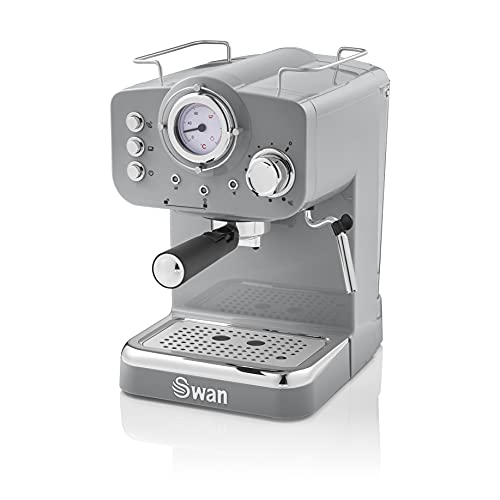How to Make Espresso Machine Coffee
Espresso machines can produce a delicious cup, but they require more care and setup than a standard coffee maker. It also requires that you grind and tamp your own beans.
The most important ingredient in making espresso is pressure. Here's how an espresso machine operates: a heating vessel is used to heat water to a suitable temperature and then forces it through the grounds and out the spouts.
Temperature
Espresso is produced by pushing hot water under pressure through finely ground coffee beans. The temperature of the water is critical to the quality of the final shot. Low temperatures result in less extraction of essential flavor compounds. Temperatures that are too high can result in over extraction, which can result in a bitter or burned taste.

The ideal temperature for espresso is between 195 and 205degF. This temperature can be achieved using a grouphead that is designed to maintain an unchanging temperature and stability throughout the process of brewing. The E61 is the most sought-after group head since it offers the ability to stabilize temperature, pre-infusion, and lever control.
It is essential to consider the temperature when adjusting your espresso machine for different roasts or brew ratios. simply click the up coming post as well as the crema. The ideal temperature will vary depending on the roast and bean. However, a general rule is that lighter roasts with higher brew rate require higher temperatures. A good thermocouple is also crucial to keep a constant temperature.
Pressure
During the brewing procedure espresso machine coffee is pushed through finely ground coffee grounds that have been put through a tamper. This causes chemical reactions to extract flavors, oils and other soluble elements from the beans. The beverage produced is usually more flavorful and richer.
The ideal espresso machine's pressure is nine bars of pressure which is the same as atmospheric pressure at sea level. This is because it's at this pressure that the soluble compounds of espresso are most easily extracted.
However, some espresso machines may advertise 15 or even 20 bars of pressure. These machines may be able reach these pressure levels but they may not maintain them throughout the extraction.
One bar of pressure is equal to 32 pounds per square inch (PSI) of the tire of a car. It's four times the pressure a professional cyclist uses when pumping up their bike tires. The ability to control the espresso machine's pressure and produce consistent espressos is the key to any serious home barista.
Water
The water you use in your espresso machine is among the most crucial elements of a great cup of coffee. The correct water will allow your beans to reach their full potential, while the wrong water can lead to problems like clogged pipes or even damage your expensive espresso machine.
The best option is natural spring water that is rich in minerals for ideal espresso extraction. This water will enhance the taste of your espresso without the chalky mineral traces found in tap water or bottled waters. This is a great alternative to distilled water or reverse osmosis, which could be too pure and cause taste issues.
But, you shouldn't use a water filter that removes too many minerals from the tap water, because this could cause extraction and flavor issues. Purchase a water testing kit to determine the average hardness of the water you drink in your area. This information can be used to identify the right filtration system for your espresso machine.
Beans
The majority of coffee drinkers tend to be involved throughout the process of making espresso. They are obsessed with a variety of variables, such as temperature, pressure of water beans, milk, viscosity, and many other variables. If one of these variables is slightly off, the entire shot may taste bad.
The most important element when it comes to espresso is the beans used. Many believe that only certain kinds are suitable for espresso. While certain beans are suitable for specific uses however, any coffee bean that has been roasted can be used to make espresso. The main difference between espresso beans and regular coffee beans is that espresso beans are roasted for longer in tipycally, well past the second crack that gives them more of a dark appearance and makes them more soluble in water.
The best beans for espresso are generally medium roasted or dark roasted, which give the espresso shots their distinctive richness and vigor. Light roasted beans can also be used to make fantastic espresso, especially if they are pre-ground to make it easier for an espresso maker.
Milk
Espresso and milk are a classic combination. The coffee doesn't just boost energy levels, but the steaming milk helps to offset the bitterness of espresso and provides a delicious creamy flavor. There aren't many culinary pairings more perfect than this one!
If you choose to buy an espresso machine that can also make cappuccino or lattes make sure you look at how easy it is to use. The best espresso machines come with a jug for hot or cold milk as well as a steam wand. They also have an espresso portafilter that can be used to make the shot. Some models come with an integrated grinder, tamper, or frother.
To get rid of any condensed water the steam wand should be cleaned each day prior to use (or after every cup of espresso). This process will take around 30 seconds and is essential to ensure that your machine is operating smoothly. Inability to purge could result in an unpleasant taste or the build-up of bacteria that can affect the taste and smell of your beverages. It's easy to do and should be part of your regular maintenance routine.
